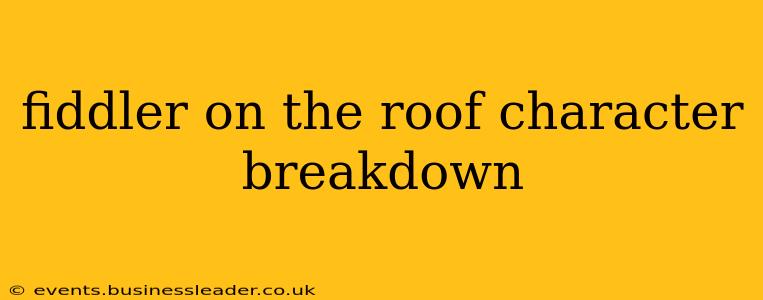"Fiddler on the Roof," the beloved musical, boasts a rich ensemble cast whose interwoven lives explore themes of tradition, change, and family. This breakdown delves into the key characters, analyzing their motivations, relationships, and contributions to the enduring power of the story.
Tevye the Milkman: The Heart of the Story
Tevye, the central character, is a poor milkman living in the small Jewish village of Anatevka. He's a deeply religious man, clinging to tradition as a way to navigate a rapidly changing world. His unwavering faith is tested constantly by the rebellious actions of his daughters, forcing him to grapple with the tension between his deeply held beliefs and the evolving desires of his family. Tevye's humor and resilience make him both relatable and endearing, even as his stubbornness leads to conflict. His inner turmoil is palpable, and his iconic soliloquies reveal his internal struggle to reconcile tradition with modernity. He represents the common man caught between the pull of the past and the uncertainties of the future.
Golde: The Steadfast Matriarch
Golde, Tevye's wife, is the pragmatic anchor of the family. While equally devout, she's more practical than Tevye and often serves as a voice of reason. She understands the necessity of change even if she doesn't always embrace it wholeheartedly. Her relationship with Tevye is a complex tapestry woven with love, respect, and occasional friction. While often portrayed as less demonstrative than Tevye, her unwavering support and strength are vital to the family's survival.
How does Golde’s role differ from Tevye’s?
Golde and Tevye represent different facets of the community's response to change. While Tevye is outwardly vocal about his struggles, Golde internalizes much of her anxiety, subtly influencing the family dynamics through quiet strength and practicality. Her pragmatism often complements Tevye’s idealism, creating a balanced and relatable portrayal of a long-standing marriage facing unprecedented challenges.
The Daughters: A Generation in Conflict
Tevye's five daughters represent the generational shift challenging traditional values. Each daughter's personality and romantic choices highlight the conflict between tradition and personal desires:
-
Tzeitel: The eldest, she embodies the struggle between filial piety and personal happiness. Her arranged marriage to Lazar Wolf is challenged by her love for Motel Kamzoil, highlighting the weight of tradition versus individual choice.
-
Hodel: She represents a more direct rebellion against tradition, marrying Perchik, a revolutionary student, defying societal expectations.
-
Chava: The youngest, she makes the most radical choice, marrying a non-Jew, resulting in the ultimate family fracture and symbolizing the complete rejection of Anatevka's traditions.
What are the different ways the daughters rebel against tradition?
Each daughter displays rebellion in different ways. Tzeitel negotiates, Hodel actively defies, and Chava completely rejects the traditional norms. This range of responses reflects the diverse ways individuals respond to societal pressures, offering a multifaceted portrayal of generational conflict.
The Other Characters: Supporting Roles with Significance
Beyond the central family, other characters contribute significantly to the story's narrative and thematic complexity:
-
Motel Kamzoil: A poor tailor who deeply loves Tzeitel, he represents the striving individual aiming for a better life.
-
Lazar Wolf: A wealthy butcher, he embodies the established order, representing a traditional match for Tzeitel.
-
Perchik: A radical student, he challenges the village's norms and inspires Hodel’s defiance.
-
Yente: The matchmaker, she represents the established social system perpetuating arranged marriages.
The Fiddler: A Symbol of Hope and Persistence
The Fiddler himself is not a character in the traditional sense, but a powerful symbol. He represents the enduring spirit of the Jewish people, clinging to hope and tradition amidst hardship and uncertainty. His presence throughout the musical underscores the theme of perseverance and the importance of maintaining one's cultural heritage.
What does the Fiddler symbolize in the musical?
The Fiddler symbolizes the enduring spirit of the Jewish people, their unwavering faith, and their ability to find joy even amidst hardship. He is a constant reminder that despite adversity, life and culture persist.
"Fiddler on the Roof" remains timeless because it explores universal themes with relatable characters. Their struggles resonate across generations, making the musical a powerful and enduring work of art.
